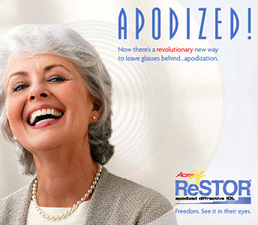About Intraocular Lens (IOL) - Lens Implants.An intraocular lens (IOL) is an implanted lens in the eye, usually replacing the existing crystalline lens because it has been clouded over by a cataract, or as a form of refractive surgery to change the eye's optical power. It usually consists of a small plastic lens with plastic side struts, called haptics, to hold the lens in place within the capsular bag inside the eye. What is the Purpose of an IOL?Each year, 2.4 million people undergo cataract surgery to remove aging, cloudy eye lenses. The natural crystalline lens inside the eye is removed during cataract surgery. The power of the natural lens must be replaced or the patient will not see clearly. There are three basic ways to replace the power of the natural lens: Contact Lens: Contact lenses were used for years between the 1950’s to the late 1970’s. The development of implantable artificial lenses made the toil of contact lenses (cleaning, inserting difficulties, high cost of replacement, risk of infections) obsolete. Today, contact lenses are rarely prescribed to replace cataracts. Eyeglasses: Because the natural lens is so powerful, using spectacles as a replacement requires heavy and thick lenses. Aside from being uncomfortable, cataract glasses cause issues with distortion and magnification, along with a form of tunnel vision, all of which makes them difficult to tolerate. IOL (Intraocular Lens): Sir Harold Ridley was the first to successfully implant an intraocular lens on November 29, 1949, at St Thomas' Hospital at London. After seeing RAF (Royal air Force) pilots of World War II with pieces of shattered canopies in their eyes, Harold Ridley noticed that plastic materials were inert and he started developing the idea. The intraocular lens did not find widespread acceptance in cataract surgery until the 1970s. A whole generation of surgeons and engineers have dedicated themselves to refining the modern lens implants. Today's IOLs bear little resemblance to the first lenses used. They are lighter, stronger, foldable, safer, and truly miraculous. Modern lens implants have undergone extensive engineering and development in the material, design, manufacturing, processes to allow extremely high precision and predictability of result when placed during cataract surgery. Currently, more than a million IOLs are implanted annually in the United States. How Are Lens Implants Prescribed?Many factors are involved in the prediction of accurate IOL power, including the length of the eye and the curvature of the cornea. The goal is not only improving a patient’s vision after cataract surgery, but ideally minimizing the need for glasses. In our office, only the latest diagnostic equipment is used to obtain the most precise measurements possible used in choosing which lens implant is correct for you. In addition to the Zeiss IOLMaster generation II and the Marco Wavefront analyzer, we use A-scan ultrasound and manual keratometry to double check our results for these critical tests. Which Lens Implant is Right for You?Eye surgeons have a variety of reasons for choosing a particular lens, for each patient, from dozens of options. These include material and optical design, plus his or her surgical experience.
Does Astigmatism Affect the Choice of Lens Implant?Astigmatism is an optical defect in which vision is blurred due to an irregular curvature of the eye. There are two common types of astigmatism:
Astigmatism is a natural variation of the human body, like the shape of an ear or toe, and doesn't normally change as we age. The astigmatic shape of an eye causes blurred vision "in general" rather than affecting the distance at which we see. To make vision sharp, light passing through the irregular shape must be re-focused, usually through the use of contact lenses or eyeglasses. When a person has cataract surgery, astigmatism can be modified as part of the operation, making it possible for the patient to see clearly after surgery without glasses or contact lenses. There are two general ways of doing this:
Toric lens implants are currently available only in monofocal powers (single
distance). A person with a toric IOL will need separate correction for
other distances. Toric IOL’s, like the near focusing lenses described above
are typically not
covered by medical insurance and must be paid for by the patient. Special measurement are made before surgery to measure the amount and particular orientation (axis) of astigmatism. From these measurements, we can determine whether a Toric IOL will be a good choice for you. Please note:
CLICK HERE: About Premium Lens Implants.
|
 (856) 667-3937Kindermann Eye Associates |
Eye Doctor South Jersey Kindermann Eye Associates - 3001 Chapel Avenue, Suite 200, Cherry Hill, New Jersey 08002Excellence in eye care for patients seeking a quality caring eye doctor in South Jersey. Dr. W Reed Kinderman is a premier ophthalmologist, New Jersey eye surgeon, specializing in cataract surgery, refractive surgery, laser guided cataract surgery, Tecnis multifocal lens implant, ReStor intraocular lens, Crystalens, Toric intraocular lens, glaucoma, strabismic eye muscle disorders, ophthalmology, and the full spectrum of eye care in New Jersey, Delaware Valley, Philadelphia, Mullica Hill, Ashland, Echelon, Thorofare, Riverton and surrounding areas. |
